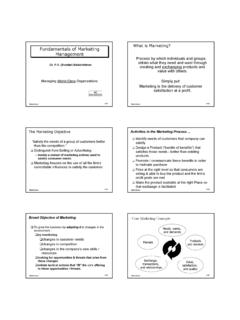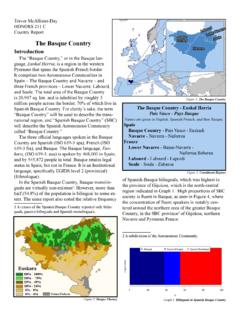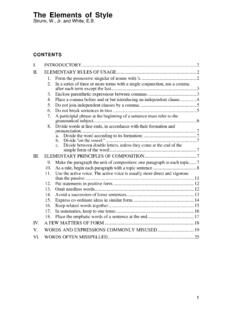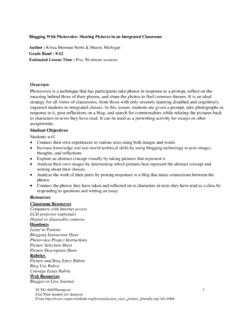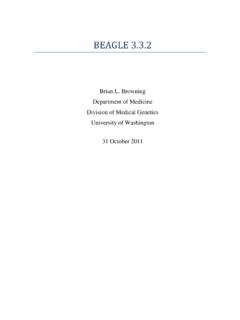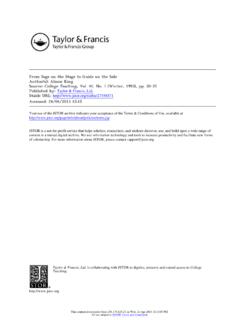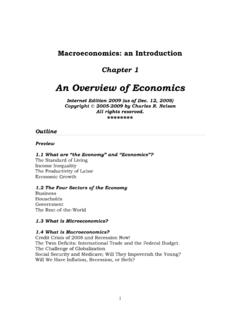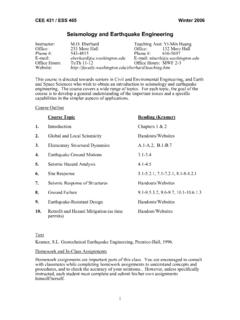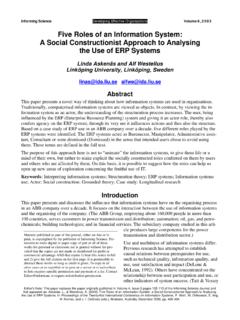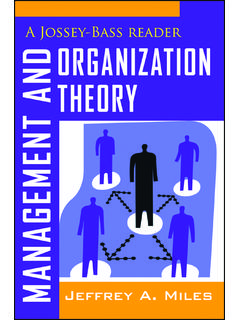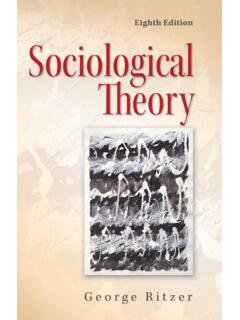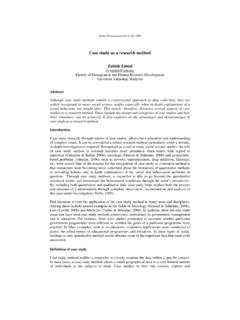Transcription of Cultural-Historical Activity Theory: A Primer
1 Cultural-Historical Activity theory : Exploring a theory to Inform Practice and Research Kirsten Foot, Associate Professor Department of Communication University of Washington February 2014. Acknowledgements: This is an Author's Original Manuscript of an article forthcoming in the Journal of Human Behavior in Social Environments [copyright Taylor & Francis]. The Journal of Human Behavior in Social Environments is available online at #.UqlMEeKRMTA . This article was commissioned by the Mack Center on Nonprofit and Public Sector Management in the Human Services, School of Social Welfare, University of California, Berkeley. An earlier version was presented to the HUSK Work Group on Evidence-informed Human Service Practice, at a workshop sponsored by the Mack Center in June, 2013.
2 The author is grateful for the helpful feedback received from the HUSK Work Group, and especially from Dr. Michael Austin. 1. Introduction In every profession, the ways in which people go about their work, how they build organizations, and how organizations interact with each other greatly affects the outcomes of the work. Interest in conceptual tools for thinking about the practices of social work is growing. A key demonstration of this is evidenced in the work of the Salisbury International Forum , (which developed into the International network on Social Work Practice Research), on how social work practices can be better theorized and researched-- with the aim of providing a basis for improved those practices (International network on Social Work Practice Research, 2013; Salisbury International Forum, 2009).
3 Cultural-Historical Activity theory (CHAT) is one of several practice-based approaches that provides a robust framework for analyzing professional work practices, including social service provision (Julkunen, 2011, 2013). By offering a multi-dimensional, systemic approach that includes both psychological motives and all kinds of tools, as well as the always-present dynamics of power, money, culture, and history, CHAT enables researchers to analyze complex and evolving professional practices, and practitioners to engage in reflective research ( Foot, 2013; Yliruka & Karvinen-Niinikoski, 2013). As an illustration, consider an ill person's visit to a doctor who works in a healthcare clinic.
4 The doctor's interactions with the ill person are framed by and set within multiple contexts--including legal, economic, cultural, and social-- that have been years in the making. The ill person views the doctor as a health expert, and the doctor views the ill person as a patient, and those reciprocal framings load their interactions with a myriad of historically-grounded, culturally- and legally-negotiated norms and scripts. The agency of each party, doctor and patient, ( the actions they take in relation to each other and the patient's illness), are both enabled and constrained by many factors that are beyond either of their individual ability to unilaterally change.
5 Although they may be alone in an examination room, their interactions are mediated by a host of other individuals and institutions, including the staff of the healthcare clinic, the state's medical licensing board, and the patient's insurance company. 2. There is significance in each word in the label Cultural-Historical Activity theory . Cultural points to the premise that humans are enculturated, and everything people do is shaped by and draws upon their cultural values and resources. The term historical is used together with cultural to indicate that since cultures are grounded in histories, and evolve over time, therefore analyses of what people do at any point in time must be viewed in light of the historical trajectories in which their actions take place.
6 The term Activity refers to what people do together, and is modified by both cultural and historical to convey its situatedness. theory is used in this label to denote a conceptual framework for understanding and explaining human Activity . CHAT centers on three core ideas: 1) humans act collectively, learn by doing, and communicate in and via their actions; 2) humans make, employ, and adapt tools of all kinds to learn and communicate;. and 3) community is central to the process of making and interpreting meaning and thus to all forms of learning, communicating, and acting (Vygotsky, 1978). The CHAT model of an Activity system that is constantly evolving through collective learning actions, in response to systemic contradictions, enables multi-faceted analyses of the complex practices of professional work.
7 The essential task of CHAT analysis is to grasp the systemic whole of an Activity , not just its separate components. This makes possible the analysis of a multitude of relations within an Activity system, both at a particular point in time, and as it evolves over time. To elaborate, CHAT provides a framework for analyzing interactions between professionals and their clients that includes not only the interpersonal/communicative aspects of those relationships, but also the cultural, historical, political and economic dimensions. In addition to illuminating the interactions between individual doctors and patients, or social workers and clients, or any other professional dyad, CHAT has potential utility for analyzing healthcare and social service provider organizations as well in relation to their cultural and historical contexts.
8 To illustrate, Sandra Bloom 3. and her collaborators at the Center for Nonviolence and Social Justice have written extensively about the dis/stress and trauma which human service delivery organizations undergo, contending that better understanding of the impacts of chronic stress on such organizations is critical to their survival, much less their efficacy. In describing how trauma can beset human service provider organizations, the center's website explains: Our evidence supports that many sources of chronic workplace stress result in organizations that are chronically hyperaroused, have lost the capacity to manage emotions institutionally, and as a result fail to learn from experience.
9 In this way, our organizations can develop learning disabilities accompanied by organizational amnesia. Under such circumstances, the most emotionally charged information becomes undiscussable and organizations develop alexithymia . Leaders are likely to become more authoritarian and punitive, workers respond with more aggressive and passive-aggressive behavior and the entire environment becomes progressively more violent and unjust. Despite this apparent deterioration, the likelihood is that chronically stressed organizations will simply continue to repeat the past, engaging in reenactment and as a result, steadily deteriorating. 1. Analyzing a chronically and/or traumatically stressed social service organization as an Activity system, and in particular employing the systemic contradictions that will be introduced below as analytical lenses, may help illuminate the extra-organizational dynamics that are causing or exacerbating stress and shaping interpersonal relations both within the organization and between service providers and their clients.
10 Although CHAT is not yet widely known in the , it is being employed by scholar-practitioners across a diverse array of fields to advance ways of thinking about and shaping professional practices such as developing curricula and teaching at all education levels (Cole, 1996; Jonassen & Rohrer- Murphy, 1999; Roth & Lee, 2007), providing mental health care (Sundet, 2010), strategizing and managing organizational processes (Blackler, Crump, & McDonald, 1999, 2000), designing digital technologies (Kaptelinin & Nardi, 2006), tracing the computerization of architectural design (Groleau, 1 4. Demers, Lalancette, & Barros, 2012), developing public policy (Canary, 2007, 2010; Canary & McPhee, 2008), and analyzing work.
